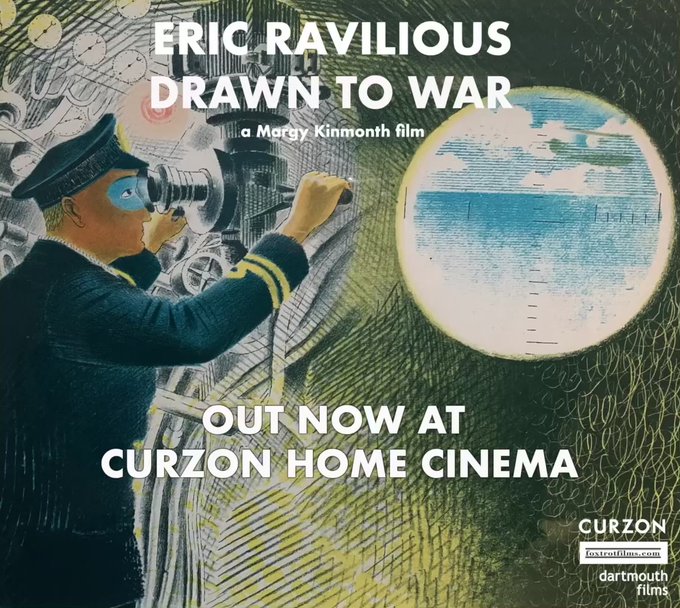Eric Ravilious: Drawn to War, directed by Margy Kinmonth. Film review by Jane Kelly

Eric Ravilious: Drawn to War. Film 87 mins. At selected cinemas. Some with Q&A
Visiting an exhibition of work by John Nash, brother of the more famous Paul, last summer at the Towner Gallery, Eastbourne, I was intrigued to see a Wedgewood dinner service designed by Eric Ravilious on a lower floor. I’ve often seen his designs on merchandise, it sells well to the public but when I mentioned his name people seemed vague about him. Few seemed aware of his unique work, before and during the last war. He was killed flying over Iceland in 1942, aged thirty-nine, the first war artist to die on active service. Since then, he’s been largely forgotten.
Bafta Award winning film maker, Margy Kinmonth, 68, has rediscovered his genius in this small, delightful film, the sort of penetrating work once enjoyed by BBC audiences, in the distant past. Voiced by Freddie Fox, Harriet Walter, and Jeremy Irons, with guest appearances from Ai Weiwei, Alan Bennett and Grayson Perry, it’s showing at 130 cinemas, and tickets were hard to come-by. Extra screenings are on as so many now want to see the forgotten painter’s work.
In the film his wife, Tirzah Garwood, voiced by Tamsin Greig, says he was always kept back as an artist because he was, ‘Not quite a gentleman.’ Class prejudice can’t really explain why he so completely disappeared from view and become, ‘A shared secret,’ as Alan Bennett put it, one of his fondest admirers. ‘Because his paintings are so accessible I don’t think he’s thought to be a great artist,’ Bennett suggests. ‘I’m not sure he’s properly estimated because he’s so easy to like.’ That’s the most positive view of his obscurity. Tate Britain and other galleries holding his work treat him as a non-person. Most contemporary curators see him as a quaint decorative pastoralist and worse, someone dangerously nostalgic about a country and its culture best forgotten.
In his short life, Ravilious was one of the most prolific and beloved English artists using traditional watercolour, pen and ink and woodcut, but his kind of art; based on craft and skill has been effectively cancelled since the 1970s. He engraved more than 400 illustrations and drew over 40 lithographic designs for books and publications. His woodcut of two Victorian cricketers has graced the cover of Wisden since 1938. After a brief experiment in oils, he painted almost entirely in watercolour, showing us an England mysterious and beautiful and vulnerable. He became well-known for his landscapes showing ancient landmarks cut out of chalk, such as The Westbury Horse, and the Wilmington Giant, 1939, built up with a dry-brush in layers of pattern, the giant framed by vicious looking modern barbed wire. From a tranquil English provincial scene, he created a disturbing world where everything valued is under threat.
His interiors, painted on site, look simple but were meticulously composed with lines and angles subtly distorted. His cottage bedrooms, painted in the Sussex Downs, with their patterned wall- paper and empty chairs, look like rooms we think we remember from childhood. Despite rarely painting people, as the film points out, work such as, Tea at Furlongs, 1939, show a tea laid out, ready for people to appear. His Train Landscape, giving a fleeting glimpse of a still, timeless view from a train window is slightly crooked, odd and disconcerting. Like many German painters at that time, with their ‘New Objectivity,’ his work is traditional and calm at first glance but full of unease.
Watching the film, which presents image after dazzling image, showing his huge ability with design, is like visiting a brilliant exhibition whilst an intelligent curator walks beside filling you with fascinating facts. These include a detailed family background. That’s possible because in the 1970s Ravilious’ children found long-lost art work and family documents under a bed, giving Kinmonth a wealth of primary source material. She structures her documentary around letters, photos and diary entries.
She gives Tirzah Garwood, who was a successful engraver, a share in the story, allowing her to emerge as an interesting woman who put aside her own artistic ambitions to take care of their cash-strapped family, enduring his long absences as a war artist and numerous infidelities. Her engraving, The Wife, seen in the film, shows a woman sitting up in bed, with her husband’s side empty. Ravilious wrote her excited letters about all his wartime adventures, while she struggled at home, bringing up their three children in a freezing, frequently flooded house in Essex and working as an illustrator. Nine years after his death she died from cancer. The film, which starts with distant landscapes, becomes an intimate and moving tale about the vicissitudes of an English family in war.
Jane Kelly
Breaking News! ERIC RAVILIOUS - DRAWN TO WAR is NOW AVAILABLE to download at Curzon Home Cinema. Click the link NOW https://homecinema.curzon.com/film/eric-ravilious-drawn-to-war/… #curzon #raviliousfilm #ondemand #streaming #curzonhomecinema